The Jargon File by Eric S. Raymond (ebook reader android txt) 📕
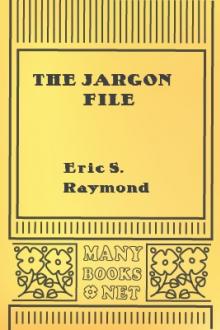
- Author: Eric S. Raymond
- Performer: -
Book online «The Jargon File by Eric S. Raymond (ebook reader android txt) 📕». Author Eric S. Raymond
where the text does not specify that a straight technical sense is
under discussion, these are marked with `[techspeak]' as an etymology.
Some entries have a primary sense marked this way, with subsequent
jargon meanings explained in terms of it.
We have also tried to indicate (where known) the apparent origins of
terms. The results are probably the least reliable information in the
lexicon, for several reasons. For one thing, it is well known that
many hackish usages have been independently reinvented multiple times,
even among the more obscure and intricate neologisms. It often seems
that the generative processes underlying hackish jargon formation have
an internal logic so powerful as to create substantial parallelism
across separate cultures and even in different languages! For another,
the networks tend to propagate innovations so quickly that `first use'
is often impossible to pin down. And, finally, compendia like this one
alter what they observe by implicitly stamping cultural approval on
terms and widening their use.
Despite these problems, the organized collection of jargon-related
oral history for the new compilations has enabled us to put to rest
quite a number of folk etymologies, place credit where credit is due,
and illuminate the early history of many important hackerisms such as
[36]kluge, [37]cruft, and [38]foo. We believe specialist
lexicographers will find many of the historical notes more than
casually instructive.
Node:Revision History, Next:[39]Jargon Construction, Previous:[40]A
Few Terms, Up:[41]Top
Revision History
The original Jargon File was a collection of hacker jargon from
technical cultures including the MIT AI Lab, the Stanford AI lab
(SAIL), and others of the old ARPANET AI/LISP/PDP-10 communities
including Bolt, Beranek and Newman (BBN), Carnegie-Mellon University
(CMU), and Worcester Polytechnic Institute (WPI).
The Jargon File (hereafter referred to as jargon-1' orthe File')
was begun by Raphael Finkel at Stanford in 1975. From this time until
the plug was finally pulled on the SAIL computer in 1991, the File was
named AIWORD.RF[UP,DOC] there. Some terms in it date back considerably
earlier ([42]frob and some senses of [43]moby, for instance, go back
to the Tech Model Railroad Club at MIT and are believed to date at
least back to the early 1960s). The revisions of jargon-1 were all
unnumbered and may be collectively considered `Version 1'.
In 1976, Mark Crispin, having seen an announcement about the File on
the SAIL computer, [44]FTPed a copy of the File to MIT. He noticed
that it was hardly restricted to `AI words' and so stored the file on
his directory as AI:MRC;SAIL JARGON.
The file was quickly renamed JARGON > (the `>' caused versioning under
ITS) as a flurry of enhancements were made by Mark Crispin and Guy L.
Steele Jr. Unfortunately, amidst all this activity, nobody thought of
correcting the term jargon' toslang' until the compendium had
already become widely known as the Jargon File.
Raphael Finkel dropped out of active participation shortly thereafter
and Don Woods became the SAIL contact for the File (which was
subsequently kept in duplicate at SAIL and MIT, with periodic
resynchronizations).
The File expanded by fits and starts until about 1983; Richard
Stallman was prominent among the contributors, adding many MIT and
ITS-related coinages.
In Spring 1981, a hacker named Charles Spurgeon got a large chunk of
the File published in Stewart Brand's "CoEvolution Quarterly" (issue
29, pages 26-35) with illustrations by Phil Wadler and Guy Steele
(including a couple of the Crunchly cartoons). This appears to have
been the File's first paper publication.
A late version of jargon-1, expanded with commentary for the mass
market, was edited by Guy Steele into a book published in 1983 as "The
Hacker's Dictionary" (Harper & Row CN 1082, ISBN 0-06-091082-8). The
other jargon-1 editors (Raphael Finkel, Don Woods, and Mark Crispin)
contributed to this revision, as did Richard M. Stallman and Geoff
Goodfellow. This book (now out of print) is hereafter referred to as
`Steele-1983' and those six as the Steele-1983 coauthors.
Shortly after the publication of Steele-1983, the File effectively
stopped growing and changing. Originally, this was due to a desire to
freeze the file temporarily to facilitate the production of
Steele-1983, but external conditions caused the `temporary' freeze to
become permanent.
The AI Lab culture had been hit hard in the late 1970s by funding cuts
and the resulting administrative decision to use vendor-supported
hardware and software instead of homebrew whenever possible. At MIT,
most AI work had turned to dedicated LISP Machines. At the same time,
the commercialization of AI technology lured some of the AI Lab's best
and brightest away to startups along the Route 128 strip in
Massachusetts and out West in Silicon Valley. The startups built LISP
machines for MIT; the central MIT-AI computer became a [45]TWENEX
system rather than a host for the AI hackers' beloved [46]ITS.
The Stanford AI Lab had effectively ceased to exist by 1980, although
the SAIL computer continued as a Computer Science Department resource
until 1991. Stanford became a major [47]TWENEX site, at one point
operating more than a dozen TOPS-20 systems; but by the mid-1980s most
of the interesting software work was being done on the emerging BSD
Unix standard.
In April 1983, the PDP-10-centered cultures that had nourished the
File were dealt a death-blow by the cancellation of the Jupiter
project at Digital Equipment Corporation. The File's compilers,
already dispersed, moved on to other things. Steele-1983 was partly a
monument to what its authors thought was a dying tradition; no one
involved realized at the time just how wide its influence was to be.
By the mid-1980s the File's content was dated, but the legend that had
grown up around it never quite died out. The book, and softcopies
obtained off the ARPANET, circulated even in cultures far removed from
MIT and Stanford; the content exerted a strong and continuing
influence on hacker language and humor. Even as the advent of the
microcomputer and other trends fueled a tremendous expansion of
hackerdom, the File (and related materials such as the [48]Some AI
Koans in Appendix A) came to be seen as a sort of sacred epic, a
hacker-culture Matter of Britain chronicling the heroic exploits of
the Knights of the Lab. The pace of change in hackerdom at large
accelerated tremendously -- but the Jargon File, having passed from
living document to icon, remained essentially untouched for seven
years.
This revision contains nearly the entire text of a late version of
jargon-1 (a few obsolete PDP-10-related entries were dropped after
careful consultation with the editors of Steele-1983). It merges in
about 80% of the Steele-1983 text, omitting some framing material and
a very few entries introduced in Steele-1983 that are now also
obsolete.
This new version casts a wider net than the old Jargon File; its aim
is to cover not just AI or PDP-10 hacker culture but all the technical
computing cultures wherein the true hacker-nature is manifested. More
than half of the entries now derive from [49]Usenet and represent
jargon now current in the C and Unix communities, but special efforts
have been made to collect jargon from other cultures including IBM PC
programmers, Amiga fans, Mac enthusiasts, and even the IBM mainframe
world.
Eric S. Raymond [50]esr@snark.thyrsus.com maintains the new File
with assistance from Guy L. Steele Jr. [51]gls@think.com; these are
the persons primarily reflected in the File's editorial `we', though
we take pleasure in acknowledging the special contribution of the
other coauthors of Steele-1983. Please email all additions,
corrections, and correspondence relating to the Jargon File to
[52]jargon@thyrsus.com.
(Warning: other email addresses appear in this file but are not
guaranteed to be correct later than the revision date on the first
line. Don't email us if an attempt to reach your idol bounces -- we
have no magic way of checking addresses or looking up people.)
The 2.9.6 version became the main text of "The New Hacker's
Dictionary", by Eric Raymond (ed.), MIT Press 1991, ISBN
0-262-68069-6.
The 3.0.0 version was published in September 1993 as the second
edition of "The New Hacker's Dictionary", again from MIT Press (ISBN
0-262-18154-1).
If you want the book, you should be able to find it at any of the
major bookstore chains. Failing that, you can order by mail from
The MIT Press 55 Hayward Street Cambridge, MA 02142
or order by phone at (800)-356-0343 or (617)-625-8481.
The maintainers are committed to updating the on-line version of the
Jargon File through and beyond paper publication, and will continue to
make it available to archives and public-access sites as a trust of
the hacker community.
Here is a chronology of the high points in the recent on-line
revisions:
Version 2.1.1, Jun 12 1990: the Jargon File comes alive again after a
seven-year hiatus. Reorganization and massive additions were by Eric
S. Raymond, approved by Guy Steele. Many items of UNIX, C, USENET, and
microcomputer-based jargon were added at that time.
Version 2.9.6, Aug 16 1991: corresponds to reproduction copy for book.
This version had 18952 lines, 148629 words, 975551 characters, and
1702 entries.
Version 2.9.7, Oct 28 1991: first markup for hypertext browser. This
version had 19432 lines, 152132 words, 999595 characters, and 1750
entries.
Version 2.9.8, Jan 01 1992: first public release since the book,
including over fifty new entries and numerous corrections/additions to
old ones. Packaged with version 1.1 of vh(1) hypertext reader. This
version had 19509 lines, 153108 words, 1006023 characters, and 1760
entries.
Version 2.9.9, Apr 01 1992: folded in XEROX PARC lexicon. This version
had 20298 lines, 159651 words, 1048909 characters, and 1821 entries.
Version 2.9.10, Jul 01 1992: lots of new historical material. This
version had 21349 lines, 168330 words, 1106991 characters, and 1891
entries.
Version 2.9.11, Jan 01 1993: lots of new historical material. This
version had 21725 lines, 171169 words, 1125880 characters, and 1922
entries.
Version 2.9.12, May 10 1993: a few new entries & changes, marginal
MUD/IRC slang and some borderline techspeak removed, all in
preparation for 2nd Edition of TNHD. This version had 22238 lines,
175114 words, 1152467 characters, and 1946 entries.
Version 3.0.0, Jul 27 1993: manuscript freeze for 2nd edition of TNHD.
This version had 22548 lines, 177520 words, 1169372 characters, and
1961 entries.
Version 3.1.0, Oct 15 1994: interim release to test WWW conversion.
This version had 23197 lines, 181001 words, 1193818 characters, and
1990 entries.
Version 3.2.0, Mar 15 1995: Spring 1995 update. This version had 23822
lines, 185961 words, 1226358 characters, and 2031 entries.
Version 3.3.0, Jan 20 1996: Winter 1996 update. This version had 24055
lines, 187957 words, 1239604 characters, and 2045 entries.
Version 3.3.1, Jan 25 1996: Copy-corrected improvement on 3.3.0
shipped to MIT Press as a step towards TNHD III. This version had
24147 lines, 188728 words, 1244554 characters, and 2050 entries.
Version 3.3.2, Mar 20 1996: A number of new entries pursuant on 3.3.2.
This version had 24442 lines, 190867 words, 1262468 characters, and
2061 entries.
Version 3.3.3, Mar 25 1996: Cleanup before TNHD III manuscript freeze.
This version had 24584 lines, 191932 words, 1269996 characters, and
2064 entries.
Version 4.0.0, Jul 25 1996: The actual TNHD III version after
copy-edit. This version had 24801 lines, 193697 words, 1281402
characters, and 2067 entries.
Version 4.1.0, 8 Apr 1999: The Jargon File rides again after three
years. This version had 25777 lines, 206825 words, 1359992 characters,
and 2217 entries.
Version 4.1.1, 18 Apr 1999: Corrections for minor errors in 4.1.0, and
some new entries. This version had 25921 lines, 208483 words, 1371279
characters, and 2225 entries.
Version 4.1.2, 28 Apr 1999: Moving texi2html out of the production
path. This version had 26006 lines, 209479 words, 1377687 characters,
and 2225 entries.
Version 4.1.3, 14 Jun 1999: Minor updates and markup fixes. This
version had 26108 lines, 210480 words, 1384546 characters, and 2234
entries.
Version 4.1.4, 17 Jun 1999: Markup fixes for framed HTML. This version
had 26117 lines, 210527 words, 1384902 characters, and 2234 entries.
Version 4.2.0, 31 Jan 2000: Fix processing of URLs. This
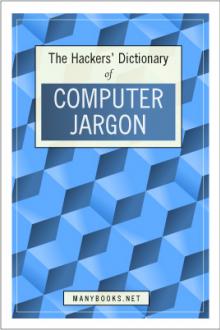

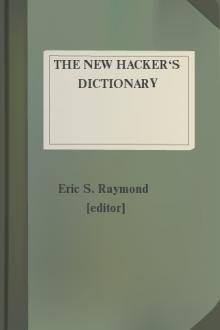
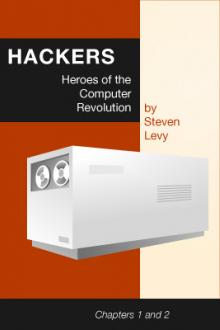
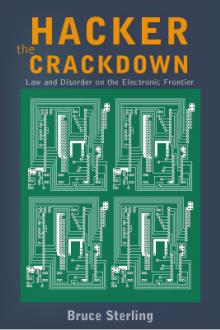
Comments (0)